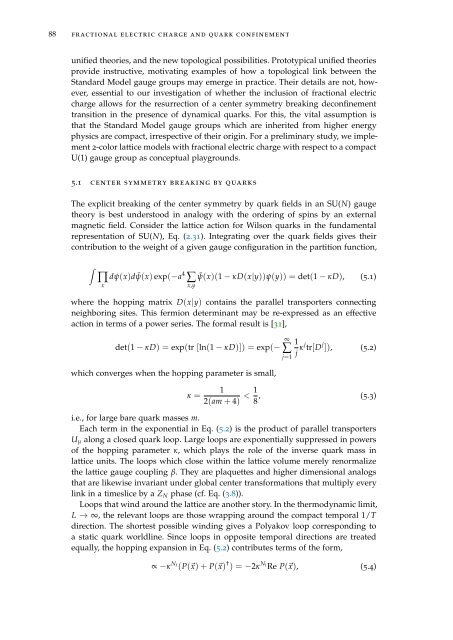Topology, symmetry, and phase transitions in lattice gauge ... - tuprints
Topology, symmetry, and phase transitions in lattice gauge ... - tuprints
Topology, symmetry, and phase transitions in lattice gauge ... - tuprints
Create successful ePaper yourself
Turn your PDF publications into a flip-book with our unique Google optimized e-Paper software.
88 fractional electric charge <strong>and</strong> quark conf<strong>in</strong>ement<br />
unified theories, <strong>and</strong> the new topological possibilities. Prototypical unified theories<br />
provide <strong>in</strong>structive, motivat<strong>in</strong>g examples of how a topological l<strong>in</strong>k between the<br />
St<strong>and</strong>ard Model <strong>gauge</strong> groups may emerge <strong>in</strong> practice. Their details are not, however,<br />
essential to our <strong>in</strong>vestigation of whether the <strong>in</strong>clusion of fractional electric<br />
charge allows for the resurrection of a center <strong>symmetry</strong> break<strong>in</strong>g deconf<strong>in</strong>ement<br />
transition <strong>in</strong> the presence of dynamical quarks. For this, the vital assumption is<br />
that the St<strong>and</strong>ard Model <strong>gauge</strong> groups which are <strong>in</strong>herited from higher energy<br />
physics are compact, irrespective of their orig<strong>in</strong>. For a prelim<strong>in</strong>ary study, we implement<br />
2-color <strong>lattice</strong> models with fractional electric charge with respect to a compact<br />
U(1) <strong>gauge</strong> group as conceptual playgrounds.<br />
5.1 center <strong>symmetry</strong> break<strong>in</strong>g by quarks<br />
The explicit break<strong>in</strong>g of the center <strong>symmetry</strong> by quark fields <strong>in</strong> an SU(N) <strong>gauge</strong><br />
theory is best understood <strong>in</strong> analogy with the order<strong>in</strong>g of sp<strong>in</strong>s by an external<br />
magnetic field. Consider the <strong>lattice</strong> action for Wilson quarks <strong>in</strong> the fundamental<br />
representation of SU(N), Eq. (2.31). Integrat<strong>in</strong>g over the quark fields gives their<br />
contribution to the weight of a given <strong>gauge</strong> configuration <strong>in</strong> the partition function,<br />
∫<br />
∏ dψ(x)d ¯ψ(x) exp(−a 4 ∑<br />
x<br />
x,y<br />
¯ψ(x)(1 − κD(x|y))ψ(y)) = det(1 − κD), (5.1)<br />
where the hopp<strong>in</strong>g matrix D(x|y) conta<strong>in</strong>s the parallel transporters connect<strong>in</strong>g<br />
neighbor<strong>in</strong>g sites. This fermion determ<strong>in</strong>ant may be re-expressed as an effective<br />
action <strong>in</strong> terms of a power series. The formal result is [31],<br />
det(1 − κD) = exp(tr [ln(1 − κD)]) = exp(−<br />
which converges when the hopp<strong>in</strong>g parameter is small,<br />
κ =<br />
∞<br />
∑<br />
j=1<br />
1<br />
j κj tr[D j ]), (5.2)<br />
1<br />
2(am + 4) < 1 8 , (5.3)<br />
i.e., for large bare quark masses m.<br />
Each term <strong>in</strong> the exponential <strong>in</strong> Eq. (5.2) is the product of parallel transporters<br />
U µ along a closed quark loop. Large loops are exponentially suppressed <strong>in</strong> powers<br />
of the hopp<strong>in</strong>g parameter κ, which plays the role of the <strong>in</strong>verse quark mass <strong>in</strong><br />
<strong>lattice</strong> units. The loops which close with<strong>in</strong> the <strong>lattice</strong> volume merely renormalize<br />
the <strong>lattice</strong> <strong>gauge</strong> coupl<strong>in</strong>g β. They are plaquettes <strong>and</strong> higher dimensional analogs<br />
that are likewise <strong>in</strong>variant under global center transformations that multiply every<br />
l<strong>in</strong>k <strong>in</strong> a timeslice by a Z N <strong>phase</strong> (cf. Eq. (3.8)).<br />
Loops that w<strong>in</strong>d around the <strong>lattice</strong> are another story. In the thermodynamic limit,<br />
L → ∞, the relevant loops are those wrapp<strong>in</strong>g around the compact temporal 1/T<br />
direction. The shortest possible w<strong>in</strong>d<strong>in</strong>g gives a Polyakov loop correspond<strong>in</strong>g to<br />
a static quark worldl<strong>in</strong>e. S<strong>in</strong>ce loops <strong>in</strong> opposite temporal directions are treated<br />
equally, the hopp<strong>in</strong>g expansion <strong>in</strong> Eq. (5.2) contributes terms of the form,<br />
∝ −κ N t<br />
(P(⃗x) + P(⃗x) † ) = −2κ N t<br />
Re P(⃗x), (5.4)
















